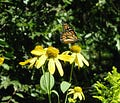This is the time of year for yellow…and rudbeckia plants….to brighten up the end of summer. I have three varieties in my yard - two native and one cultivar. They are such easy plants to grow and require little maintenance.
The largest and the most unruly of my varieties is the green-headed coneflower (rudbeckia laciniata). I initially saw them growing in a ditch by the side of the road and harvested some seeds for my backyard. Little did I know that they would not only establish quickly but then take over much of my wetland buffer. Given the right environment - moist, organic soils and part sun - these plants will thrive to the point of being a nuisance. In looking them up on the internet, I see they were affectionately named in cottage gardens as the “outhouse flower” due to their propensity to grow tall in masses which would screen the privy. Unfortunately when they do get tall, they will droop over and they do produce a fair amount of plant material with their thick stalks.
To wildlife this rudbeckia is a star. Butterflies and bees swarm the plants starting in mid-August. Then when the florets mature, they produce seed heads that are prized by the American Goldfinch.

From the New Moon Nursery website:
LANDSCAPE USES: Rudbeckia laciniata is a dramatic Accent for a Wildlife Garden or moist Meadow. Plants are also used as Butterfly Nectar Plants or as part of a Grouping or Mass Planting. This wildflower offers Showy Blooms and provides Erosion Control. It is useful in Stormwater Management and Rain Gardens. It can be used in Cottage Gardens, Deer Resistant Plantings, Low Maintenance Plantings, Perennial Borders or Shade Gardens.
Brown Eyed Susan (Rudbeckia triloba) is other native rudbeckia in my wetland buffer that was started from seeds as well. It is a biennial that self-seeds so it “travels” to different spots in the buffer each year.
From the Prairie Nursery website:
Brown Eyed Susan offers a profusion of brilliant yellow flowers with jet-black centers blooming from late July up until the first hard frost. This Rudbeckia grows from two to five feet tall, in a bushy habit with an open airy quality. Its lovely informal style is an excellent complement to any of the tall native grasses and common prairie wildflowers….Although short-lived, it self-sows readily on open soil. It prefers moderate moisture, but is very adaptable, and grows in almost any soil in full sun or light shade.
It is also a desirable plant for pollinators and provides seeds for birds in the fall.
Lastly I do have the Black Eyed Susan cultivar ‘Goldstrum’ growing in my gardens. It is very easy to grow and stays upright and contained. As it thrives, it can be transplanted this time of year to new areas. Another great rudbeckia for pollinators, birds and garden-lovers.








